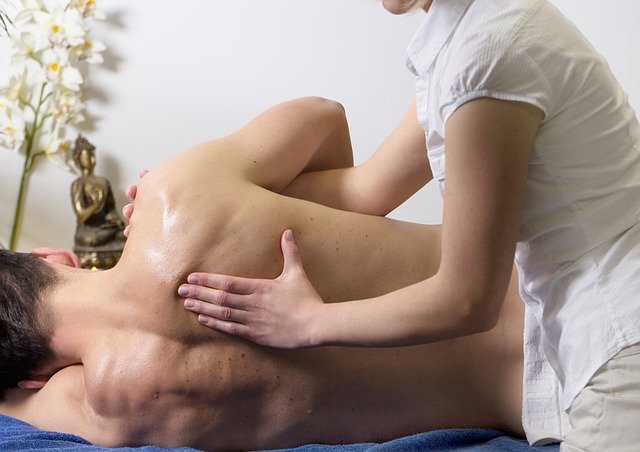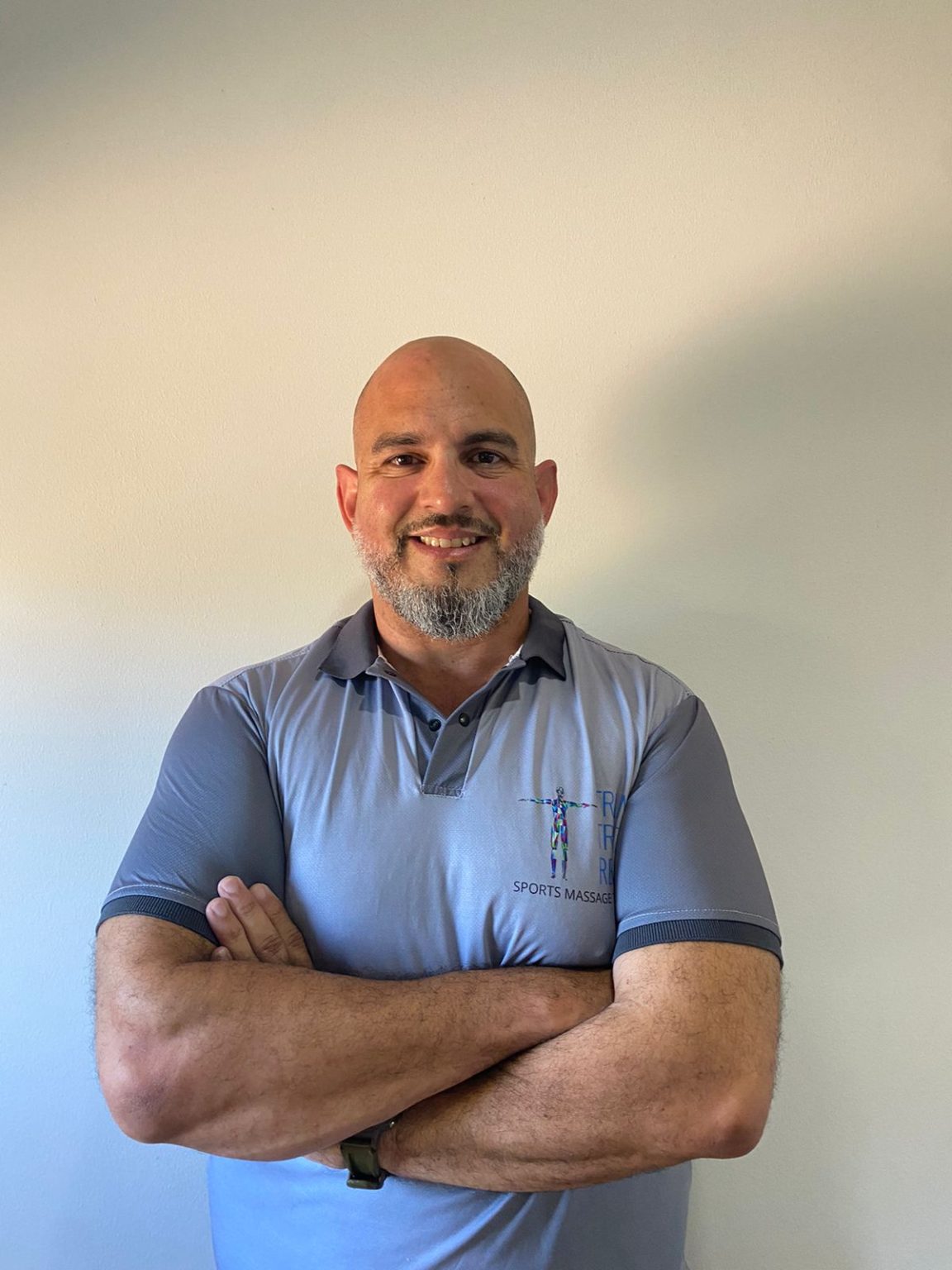Maychell is not a common name in Belgium. This Aruban came down to beautiful Hoeilaart a few months ago where a nice balance was struck between work and leisure and, above all, discovering our beautiful Belgium. We thought it was time to sit down with this special man with a passion for taking care of athletes, especially non-athletes 😉 .
You haven't always been a massage expert. Tell us about where you come from and what led you to make the switch to massage therapist?
Yes I did. From the age of 17, I was employed by the Aruba Police Force. After a year working in the street service, I was hired in the robbery team and then in the Organised Crime Section. Since then, my career with the Criminal Investigation Department began. In 2001, my wife and I moved to the Netherlands where I joined the Addiction Service. In the process, I followed a higher vocational education study. In 2006, we moved to Portugal. A year later, we returned to Aruba. There I resumed working as a detective and specialised in vice investigations.
At the time, my daughter was swimming with the Barracudas Synchronised Swimming team and later with a competitive swimming team 'Giants'. Together with another 'athlete mother', we started training as 'sports massage therapist' to help our children with their sports careers. I found the training fascinating and quickly learnt the basic techniques of massage and anatomy. My interest quickly grew in the sports world where I took several online courses to gain knowledge. A year and a half later, I finalised the entire course.
During Covid, people's interest in doing sports increased. I then started giving sports massages to athletes 'in the open air' behind my garden under a tree. A year later, I discovered other techniques like scrapping, pressotherapy, heat/cryotherapy, deep stretching and cupping. I saw athletes progress in great strides in their sports (running, swimming and or triathlon). I got more and more different athletes far the floor because they felt better prepared and the 'recovery' went faster. Their injuries passed faster and they could continue their sports training and competitions without pain.
At the time, I had the fastest runner in Aruba as a sponsor athlete. He started breaking all records after undergoing my treatment. In the process, I also had the best triathlete who also started breaking Aruban records. My treatments then quickly became known among all athletes in Aruba. National selection teams asked for my help such as the Aruba swimming team, National women's football team, beach tennis, Golf, MMA, UCF, karate and athletes competing in (ultra)marathons and ironmans. I was the therapist of a team that swam from Bonaire to Curaçao in the open sea. In the process, I was also therapist to 48 swimmers of a swim team called Giants.
Why is massage good? For what reasons should people make an appointment with you.
Sports massage is a massage aimed at stimulating blood flow to the muscles. With a sports massage, you ensure that waste products in your muscles are removed faster. As a result, you promote the recovery of your muscles and body. Sports massage is also used preventively to prevent injuries. If you suffer from an injury, a sports massage ensures faster recovery. Connective tissue is loosened and knots are removed from your muscles. After the treatment, the feeling of pain is reduced somewhat to nil. You can also use sports massage to activate your muscles. For example, at the beginning of a training programme or if you haven't done anything for a while. In athletes doing high-impact sports like football, running, crossfit, contact sports can definitely benefit from massages. I recommend that athletes such as triathletes, cyclists, marathoner runners and swimmers definitely get weekly treatments.
There are different techniques. Can you explain a bit more about them. What are the typical massages you offer to certain people.
Depends on which person you have in front of you. I myself am a great believer in 'maintenance'. If, as an athlete, you really pursue performance, you have regular massages so that your muscles are better maintained. If the muscles feel heavy, tired or you feel cramps and acid in your muscles, the weekly treatment ensures that you don't even feel this. I feel the muscles during the treatment to see what kind of treatment is best for the athlete/client. I use soft tissue or deep tissue massage, combined with stretching exercises. During treatment, I usually use heat therapy to loosen or soften the muscle tissue so that I can do my job better through petrissage. When recovering after a marathon, etc., I use cryotherapy. I massage with a cold iron rod, a cold iron ball and cold towels to reduce inflammation. It takes some time to get to the deepest tissues, but when the goal is reached, you benefit from better and healthy muscles and improved mobility. During my career, I have already treated various problems such as sciatica, piriformis, plantaris solis, runners knee,'swimmers shoulders' and so on.
Which massages do you give the most and which do you prefer?
To be honest, I like to treat people suffering from stress at the level of neck, shoulders and lower back with deep tissu massage. These clients came for deep tissue massage at least twice a week. Besides pain, they also had problems sleeping or sitting while working so they were constantly confronted with their pain. After several months of treatment, they experienced less pain and were able to sleep better and longer. It is important to build up this treatment gradually. otherwise, clients can expect some reaction such as inflammation and fever.
Deep tissue massage is my most requested massage. I always follow the following steps during my treatment: intake, muscle analysis, aromatherapy, effleurage, deep tissue, massage gun, madero therapy, hot towel, petrissage, deep stretching, cupping therapy and then scrapping therapy.
What makes you a good massage therapist?
I think it has to do with 'the touch', the feel of the muscles. Every person is different, but muscles are muscles. I immersed myself a lot in muscle anatomy and learned about injuries. In Aruba, this was my side business. I worked from 6 to 10 in the evening and got around 7-8 clients daily. On a Saturday, I got around 10 clients.
I recognise a muscle where a scar has tissue and work on this immediately to a solution. I enjoyed relieving people faster when muscles felt heavy or stiff. I think it's important as a therapist to immerse yourself in sports so you know better which muscles are just being used. Baseball players usually have an imbalance in their muscles because they usually use one side of their body more to throw or catch the ball. They have more problems with their shoulders and ankles while a runner usually has more problems with quads or hamstrings. The difference is in how he runs and what kind of shoes he uses. Also, I took online courses of micro- and macronutrients and sports nutrition. I felt it was important to be able to talk about nutrition with an athlete who wants to perform better. After all, nutrition is very important during sports. For this, you can go to Matthias Lenaerts, sports dietitian at Healthcube, go to find out everything in detail.
When are you bookable in Healthcube?
I am bookable on Mondays, Tuesdays and Saturdays.
Maychell is a trained, certified and experienced sports massage therapist at Healthcube1. He is highly skilled in improving physical fitness, combating adverse effects of sports, or making them felt as little as possible to improve the sports performance of athletes including elite athletes1. He offers different types of massages, including deep tissue, deep stretching, cupping, heat/cryo, scrapping and aromatherapy1. These massage therapies improve flexibility, mobility and blood circulation1.


